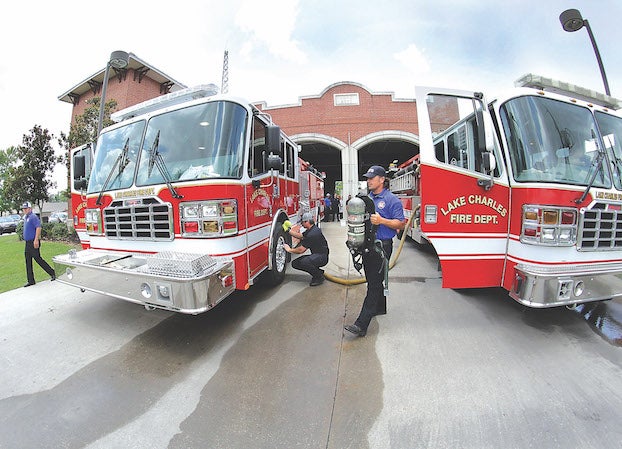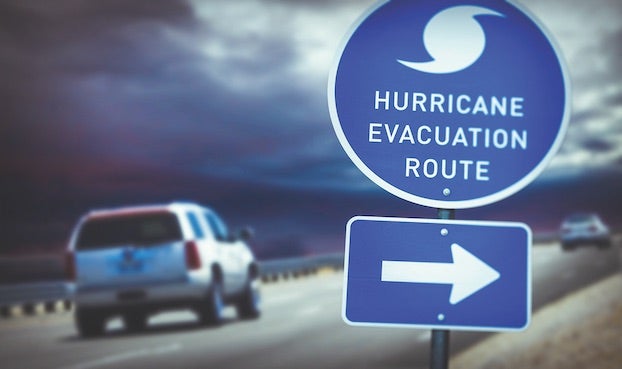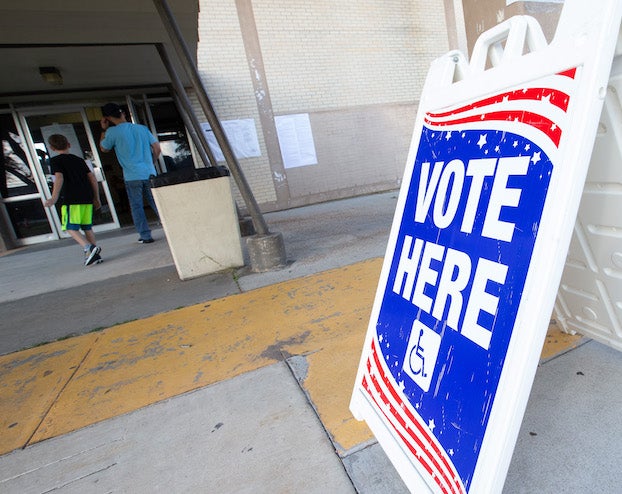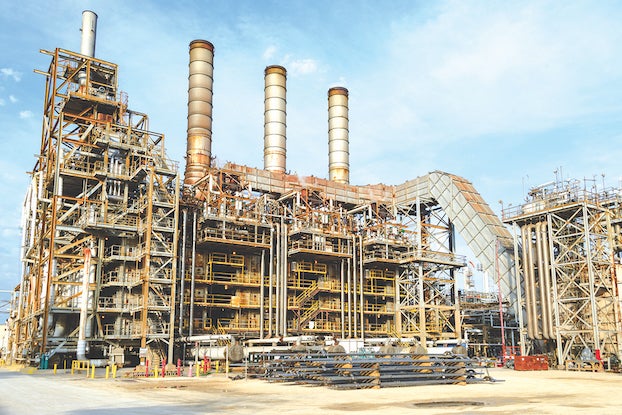New Ferrara Custom Pumper Truck now part of city’s firefighting fleet
Published 5:59 pm Friday, June 2, 2023

- As part of Friday’s Apparatus Housing Ceremony for the City of Lake Charles’ new fire truck, firefighters wipe down the tires of the new truck, left, and transfer gear from the old truck, right, to the new one at Station 4, 2622 Creole St. (Donna Price / American Press)
Station 4 of the Lake Charles Fire Department hosted the City of Lake Charles’ first Apparatus Housing Ceremony Friday, saying goodbye to truck 402-127 and hello to truck 402-192.
402-192 is the first fire truck to be bought since 2019 and cost just over $1 million.
At the Lake Charles City Council meeting on April 19, the Council authorized the city to enter into an agreement with Bulldog Fire Apparatus to purchase one new Ferrara Custom Pumper Truck. Depending on its size, these trucks can hold from 300 to 1,250 gallons of water and can have a flow rate of up to 5,500 gallons per minute.
The purchase of a new fire truck is cause enough for a ceremony, but for Delton “DC” Carter, LCFD Fire Chief, the Apparatus Housing Ceremony was an opportunity to reintroduce tradition into the Southwest Louisiana community.
“For the last couple of years, especially since COVID…tradition just seemed to take a backseat… Hopefully in the future we can bring tradition back to Lake Charles again.”
For firefighters globally, tradition is both a grounding and sustaining practice that reminds firefighters of their oath. “The fire service is steeped in tradition… there are traditions for almost everything because of the things they did in the past,” he explained. “For me, keeping and carrying on those traditions, I believe, just keeps the firemen in line of what they’re doing and keep them on task for the calling they take to be firemen.”
To Carter’s knowledge, this is the first of these ceremonies to take place in Lake Charles.
Apparatus Housing Ceremonies take place worldwide and date back to the 1830s. “I figured if they’re doing it, we should be able to, too,” Carter said.
He referred to it as a “proud tradition of the American Fire Service.”
The rituals that take place during the ceremonies are artifacts of necessities during the 19th century. During this time, when a new apparatus – usually hand or horse-drawn- was purchased by a municipality or community, the ceremony hosted to bless it and officially introduce it into service, he said
“The days of the new equipment arriving by cart and rail are long gone, but in those days the firefighters would meet the apparatus upon its arrival and parade it through town”
The first of these is the washing of the wheels and tires. This early tradition stemmed from the need, as the wheels of the carriages would often become caked in mud. Carter explained that it was common practice to keep the wooden spokes and hard wheels moist to prevent damage during use.
After cleansing the tires of 402-192, the most recognizable equipment -hoses, airpacks, extinguishes, ect. – and the water was transferred from the retiring engine.
This process symbolized the new truck’s adoption of the moniker of Engine 4, just like its predecessor (which was officially retired at the beginning of the ceremony).
The penultimate step of the apparatus ceremony was the act of pushing the new truck into Station 4.
In the past, firemen had no choice but to use manual labor to place new apparatuses into the stations. “In the horsedrawn era, most horses could not or would not back into the bay,” Carter explained.“I’m thankful to say that today our tech has improved…We may not have horses, but we still have the traditions.”
Manual push-ins are not a viable option for modern fire engines. For this reason, 402-192 was put in reverse while the hands of community members symbolically pushed the truck backwards.
The push-in ceremony was done in three parts, with prayers being said during each stop to bless the truck: One for the truck, one for the community that the truck will service and one for the firemen and station.
After the pushing ritual, the newly named Engine 4 was officially called to service.
As for truck 402-127, it will become a training truck.
The life of firetrucks is cyclical. In the coming years, as one LCFD truck is introduced and another is retired, 402-127 will be sent to auction.
Carter stated that the manufacturer’s recommended life span for a fire truck is approximately ten years, but due to the usage of LCFD’s apparatuses, the average life for a truck is five years.
LCFD has 20 trucks- pumper trucks and ladder trucks. Fifteen of these trucks are considered front line response units. The other five are reserve units.
As per the City’s agreement with Calcasieu Parish to serve the entirety of Ward 3, LCFD also has two tanker trucks to serve the areas that are not within Lake Charles’ city limits.





